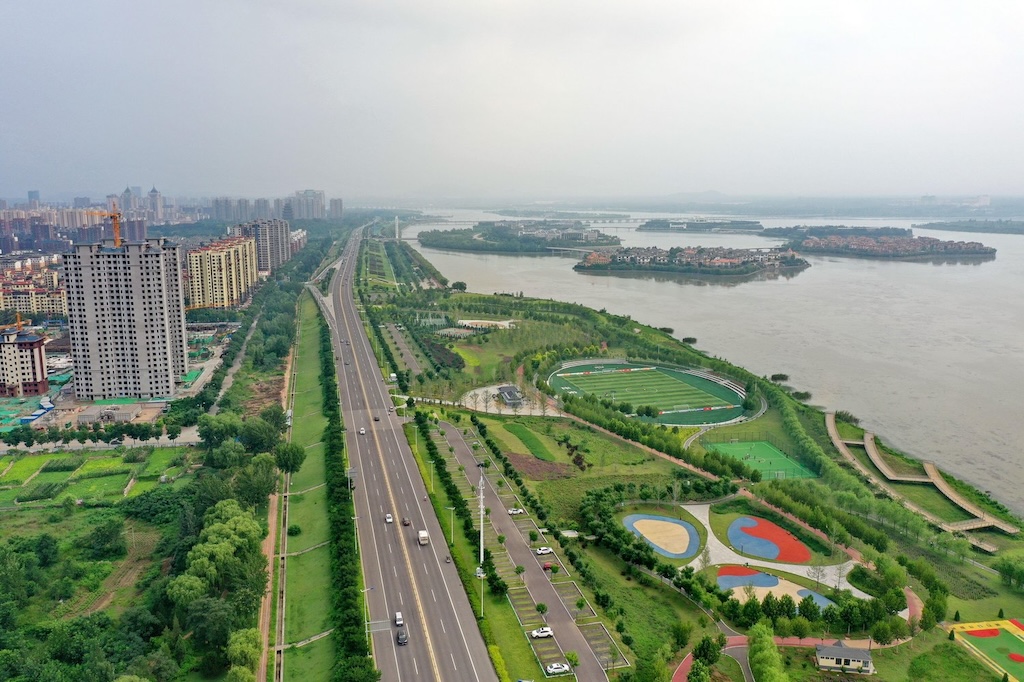Extreme weather events, such as heavy rainfall, flooding and heatwaves, have been described as the “new normal” for China.
The country lost almost 12bn yuan ($1.65bn) due to heavy rainfall and floods in April – “the worst in 10 years”. In June, dozens of people were killed and some 33 rivers in China “exceeded warning levels”. The floods in Guilin, capital city of Guangxi province, were the largest in the area since 1998.
It has been less than a year since the Beijing meteorological service recorded 745mm of rain in just five days during July 2023 – roughly the same amount the city usually receives in the whole month.
The province surrounding Beijing, Hebei, also had heavy rainfall at the same time. In July 2023, the county of Lincheng recorded more than one metre of rain, twice its annual average.
In July 2021, Hebei’s neighbouring province Henan had a “one-in-a-thousand-year” rainstorm.
While China has issued more policies to improve its emergency response system and infrastructure, the increasing number of extreme weather events continues to pose challenges.
In this Q&A, Carbon Brief looks at the reasons for China’s recent floods, how the country is adapting and whether it will need to re-examine and future-proof its flood defence systems.
What are the reasons behind the recent floods?
There are various factors behind the frequent heavy rain and flooding in recent years.
Dr Oliver Wing, honorary research fellow at the school of geographical sciences, University of Bristol, tells Carbon Brief that “on the whole, we expect a warming world to be a wetter world due to the Clausius-Clapeyron relationship”.
This relationship dictates that the air can generally hold around 7% more moisture for every 1C of temperature rise, meaning rainfall is likely to be heavier in a warmer climate.
Wing notes that “for sub-daily rainfall, we are seeing even greater scaling than this relationship would suggest. This makes surface water flooding in cities [more likely] due to short-duration, intense, localised rainfall increase”.
In addition, he says, “warming is inducing a rise in sea levels in most places, meaning storm surges have a higher baseline from which to inflict damage”.
In China, “higher than normal temperatures” were behind frequent heavy rainfall in southern coastal provinces, such as Guangdong and Guangxi, since April, says Zheng Zhihai, chief forecaster at the National Climate Centre of the China Meteorological Administration (CMA), and reported in China Daily.
Zheng adds that the El Niño-Southern Oscillation – a natural climate cycle that entered its warmer El Niño phase in mid-2023 – was partly to blame because it raised sea surface temperatures and directed vast amounts of water vapour from the South China Sea and the Bay of Bengal towards southern China.
Dr Faith Chan, head of the school of geographical sciences at the University of Nottingham Ningbo China, tells Carbon Brief that the rainfall pattern in Guangdong during this April was quite similar to the intensive rainstorm on 6-8 September in 2023 after Typhoon Haikui.
Specifically, the intense rainfalls were generated by the low-pressure moist current from the south-east and south Asian monsoon pattern crashing into another low-pressure rain belt from the Philippines and the west Pacific.
Typhoon Haikui had hit Hong Kong with the worst storm in 140 years and caused some of the heaviest rains in the provinces of Guangdong and Fujian.
While these intense rainstorms, in a meteorological sense, are not unusual, they are happening more closely to one another owing to the warming world, Chan says.
Large-scale heavy rainstorms typically occur three times on average in April – the onset of a monsoon season. But, this year, China has been battered by at least eight regional extreme rain events in the month alone, all happening in quick succession.
River floods are commonly seen in the affected regions, such as Chongqing and Hunan. Identifying the causes can be more complicated for river floods in general, says Wing:
“There are many modulating factors. Drier soils in a warming world may enable the land to absorb the increased rainfall, thereby mitigating any flood hazard increase. Many floods are not driven by intense rainfall, but are driven by snowmelt or low-intensity, long-duration rain falling on saturated soils. For this reason, it is not reasonable to extrapolate that increased rainfall in a warming world will lead to increased fluvial flooding.”
Chan says natural reasons “of course” enhanced the wetness, “but human-induced climate change led to the greenhouse effect and caused sea temperature to rise, which caused more storms and low-pressure rain belts. That is a fact”.
Wing agrees that “the thermodynamic impact” of human-led climate change increases the rainfall associated with storms. But, he adds:
“What we do not understand well is how anthropogenic climate change has altered the dynamics of the climate system, and where and how this either compounds or dampens the thermodynamic response.”
Back to top
What role does human-caused climate change play?
Many studies have found that warmer sea surface temperatures are supercharging high-impact, back-to-back extreme rains.
The sixth assessment report (AR6) from the UN’s Intergovernmental Panel on Climate Change (IPCC) also says that human-induced climate change caused by greenhouse gas emissions contributes to ocean warming and “is likely the main driver of the observed global-scale intensification of heavy precipitation over land regions”.
In east and central Asia, under 1.5C of global warming, extreme annual daily rainfall (Rx1) and five-day accumulated rainfall (Rx5) events are projected to increase by 28% and 15%, respectively, relative to 1971-2000, according to AR6.
Similarly, it says that in China’s urban agglomerations, “an increase in global warming from 1.5C to 2C is likely to increase the intensity of total precipitation of very wet days 1.8 times and double maximum five-day precipitation”.
Prof Yang Chen of the Chinese Academy of Meteorological Sciences at the CMA tells Carbon Brief that human-caused intensification of heavy rainfall over China had been even larger than expected. He explains:
“Human-caused intensification of heavy precipitation over monsoonal China is markedly larger than expected from increases in atmospheric moisture due to warming, because of stronger feedback between latent heat releases and ascending motion within wetter storms in a warmer climate.”
Such feedback, he adds, is particularly evident in eastern China compared to other regions of similar latitudes.
A recent study in Nature also anticipates storm activity over China to become more frequent and intense as a result of warming. By the end of the 21st century, the annual average frequency of tropical cyclones on the east coast of China is anticipated to increase by 16% compared to the present day, according to the study.
Apart from climate change that is caused by human activities, poorly designed and constructed cities, as well as subsidence – caused by groundwater extraction, the weight of buildings as result of urban growth, urban transportation systems and mining activities – could also amplify floods.
Dr Kevin Smiley, assistant professor from the department of sociology of Louisiana State University tells Carbon Brief:
“Climate change is increasing the severity and frequency of extreme weather. Extra rainfall induced by climate change can be the difference between a building’s parking lot hosting puddles on a rainy day compared to floodwaters crossing the threshold of the building and causing thousands of dollars of damages.
“It’s always important to remember: climate change is anthropogenic, so this increased risk also has human-caused roots.”
Back to top
How is China adapting to increasingly frequent flooding?
China has built a number of large water projects to prevent flooding, such as the south-north water transfer projects in the Yangtze river that was launched in 2002.
In the most recent “national water network construction planning outline” published by the State Council – China’s top administrative authority, the equivalent of central government – constructing “national water networks” by 2035 is among the “backbones” of future flood prevention.
The “backbones” in the document also include large hard-engineered structures on the main rivers, such as embankments, flood gates and channelised river networks, to mitigate flood risks.
Meanwhile, a study published in the journal Ocean & Coastal Management found that “nature-based solutions” have also become popular in China. The restoration and conservation of freshwater swamps, mangroves and wetlands along coastlines and river mouths are being used to provide a buffer for tidal and storm surges.
They include the Chongming Island wetland in Shanghai (Yangtze delta) and the Futian and Mai Po wetlands in Shenzhen Bay (Pearl River delta).
Another concept proposed in the planning document is to “accelerate smart development” by using the internet, data and technology to monitor and prevent floods.
The capital Beijing has incorporated data from high-definition cameras, as well as telescopes, radar maps and satellite cloud images to provide real-time hazard updates, which has improved emergency response times.
Ningbo, a port city on China’s east coast, has worked with mobile companies to analyse big data and disseminate information.
The Ministry of Emergency Management said these measures have reduced the number of deaths and missing people as a result of natural disasters by 54% over 2018-22, compared to 2013-17. The death toll continued to fall in 2023 but the number of destroyed buildings and direct economic losses rose by 97% and 13%, respectively, compared with 2018-22 levels.
In 2015, the sponge city programme (SCP) concept was written into a policy document of the Ministry of Housing and Urban-Rural Development. It was promoted across the country and 30 major cities, such as Wuhan (home to 11 million people) and Zhengzhou (home to 10 million people), were chosen to be the pilot cities.

Those sponge cities are designed to collect, purify and re-use at least 70% of the floodwaters through “green-blue facilities”, such as green roofs, permeable pavements and stormwater parks, in urban areas. The overall system was meant to resolve the issues of urban heating, freshwater scarcity and flooding all at once.
China has improved its recovery process too. In Ningbo, for example, flood victims were able to access financial compensation within an hour, using an improved online documentation process during Typhoon In-Fa in 2021.
Back to top
How effective are these measures?
Chan tells Carbon Brief that China has “done very well in terms of preparation, response and recovery for flood and drought hazards” – the two most destructive types of natural disasters.
“As a global south country,” he says, referring to China as a developing country, “China has done quite well with the SCP [sponge cities programme] and the ecologically enhanced solutions for addressing climate change”.
However, Wing argues that nature-based solutions, such as SCP, can “get saturated quickly” and so “there’s a risk of their role being overstated”. He continues:
“These types of interventions are most effective for rainfall events which occur relatively regularly at low intensities. They will be quickly overwhelmed during the very intense, rare rainfall events (whose probabilities are changing rapidly in a warming world) that cause the most damage and suffering.”
In 2021, a “historically rare” rain and flood, that affected more than 14 million people and killed 398 in Zhengzhou, a showcase sponge city, highlighted the limitations of the SCP in the face of climate change.
SCP is designed to only withstand one-in-30-year rain events, says the Nature study. On top of that, it can create a false sense of security, which encourages more people to move to high-risk areas, leading to an increase in population and assets in exposed areas that require ever-increasing protection in a cycle referred to as a “levee effect”, says Chan.
The levee effect refers to the paradox whereby the construction of a flood-defence levee leads to a lowered perception of flood risks and a greater likelihood of property owners investing in their property, increasing the potential damages should the levee breach.
The effect, according to the Nature paper, is a key challenge in the densely populated Yellow River delta and Pearl River areas, which both face high risks of flooding.
Smiley says:
“Risk is realised when social vulnerabilities intersect with hazards. Vulnerabilities are social. Flood impacts are greater when social vulnerabilities are greater…Social vulnerabilities are uneven. A household with some wealth and good insurance can recover from a flooding event much faster and more successfully than a household living paycheck-to-paycheck.”
The Chinese government has allocated more than one trillion yuan ($138bn) – via a special government bond – to support the vulnerable citizens and reconstruction of areas hit by natural disasters in March this year. More than half of the funds are used for “the construction of water conservancy projects like flood control,” reported state media outlet the Global Times.
But the delivery of financial support has been questioned in the past. When Typhoon Doksuri hit China in 2023, only $2bn out of roughly $25bn in aggregate losses were underwritten, according to global reinsurer Munich Re.
In addition, the construction of those sponge cities has already cost China 1.5-1.8bn yuan ($210-250m) between 2015 and 2018. And maintenance will make this bill even larger.
The authors of the Nature paper suggest that the government should work on integrating fragmented “grey infrastructure” – built structures such as drains, pipework and pumping stations – into existing green-blue facilities, but should not rely on engineered infrastructure alone.
Dr Lele Shu, a researcher at the northwest institute of eco-environment and resources, Chinese Academy of Sciences, tells the Intellectual magazine that “the [impact of] heavy rain at the current rate cannot be mitigated through traditional engineered approaches alone”.
“Everytime there is heavy rain, the damage it causes will make headlines primarily because there are too many people living in the city,” adds Shu.
The lack of coordination between regional governments and municipalities in flood prone areas also often led to fragmented approaches to disaster management.
In the case of the Yangtze and Pearl deltas, there is a lack of delta-wide plans that “systematically zone land and prioritise investments within one unified hydrological system”, the Nature study adds.
Dr Zheng Yan, a researcher at the Research Institute of Eco-civilisation, China Academy of Social Sciences, noted in the aftermath of the 2023 Beijing flood that government bodies often look after their own jurisdiction and aim only to move the problem and divert the floods quickly, which piled pressure on cities in downstream areas.
Smiley says:
“Floodwaters don’t care about human-created boundaries by municipality, district or province. Effective urban design in one locality may lessen flood risk there, but indirectly increase risk elsewhere. Thinking collectively while centering justice means providing spatially extensive and locally attuned solutions that help all recover effectively instead of exacerbating inequalities.”
Back to top
What can China learn from other cities?
As flooding is a challenge faced by cities across the world, there is a plethora of ideas and technologies that China can draw on.
The Nature paper suggests that the Yangtze and Pearl deltas, for example, could learn from the Ganges-Brahmaputra-Meghna delta and the Mekong delta to “improve their responses to regional challenges such as subsidence and erosion, by using and aligning with the underlying dynamics of the deltas that are rapidly changing in response to climate change and anthropogenic activities”.
Building a resilient society that is “proactive and forward-looking, with adequate capabilities to limit detrimental flooding impacts and timely return to the pre-disaster state” is also advocated by the paper.
Rotterdam, a Dutch delta city of 600,000 people that is surrounded by water on four sides, has built water storage facilities, such as an underground parking garage with a basin the size of four Olympic swimming pools. It has also installed green roofs and facades to absorb rainwater.
Japan has built an intricate network of concrete tunnels and vaults about 14 storeys beneath the Saitama prefecture in the outskirts of Tokyo, Japan’s capital city, that can hold more than 1,000 Olympic pools of rainwater.
Both cities’ underground flood diversion facilities are often used as a prime example of a viable flood defence system for urban cities on the frontline of climate change.
Hong Kong has a similar underground stormwater storage system beneath the sport pitches of the Happy Valley Racecourse, designed to withstand once-in-50-years flood events.
However, Chan says it is difficult to compare flood mitigation measures as each city is very different in terms of geography, demographic, densities and topography.
He tells Carbon Brief:
“But in my opinion, China’s megacities should think about using underground spaces to store the sudden extreme discharge from super intensive rainstorms…Tokyo and Rotterdam are quite wise (in that regard) for using their underground spaces.”
Back to top
Sharelines from this story



















Discussion about this post